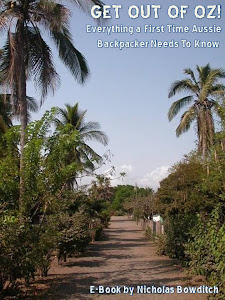Before you start the Inca Trail you have to get to a town in Peru called Cuzco. This is an amazing place, the town is full of colonial Spanish buildings built on top of old Inca sites. It was the imperial capital of the Inca world before the Spanish came and started wiping them out.
It is best to stay a few days in Cuzco to get used to the altitude and that will make your trail up to Machu Picchu a lot easier. Good advice that I didnt follow....
The only way to do the Inca Trail these days is with a tour group. This is to ensure that some of the money from tourists goes into the conservation of the track but also to limit the numbers of tourists doing it each year so that it might be preserved for more people to experience it.
The morning that you start on day one you have to the start of the trail which is at Km 88. The first day is pretty easy and covers a pretty short distance but you will see a couple of Incan ruins along the way.
After camping on the first night you head off pretty early on Day 2.
This day is by far the hardest physically, and if you are an idiot like me and didnt get used to the altitude for long enough it will be a very very hard day.
At the start it stays pretty easy until you reach Huayllabamba which means "the place of good pasture". After this the trail starts heading up. And up. And up.
Today you climb for about 9-10 hours uphill, some of it quite steep, until you reach the first pass which is called Abra de Huarmihuanusca, or 'Dead Womans Pass'. I felt sorry for this poor dead woman at this stage because I felt a bit the same by the time we got there. The altitude sickness that had kicked in meant I had to either vomit or have some diarrhoea every 4 steps which was pretty wonderful for the other 6 people in my group!
The first pass is at an altitude of 4050 metres above sea level. The air up there is pretty thin and you get buggered really easily but the views were unreal.
After you leave the pass the trail heads down (finally) towards the Pacamayo river and the campsite for the second night.
I dont remember much about that afternoon or night and I am sure the other 2 guys in my tent wish they couldnt either!
Day 3 is a bit easier than the 2nd day and by this time my body had gotten used to the altitude a bit also so it was a lot easier for me.
This day has you up and down most of the way past a lot of old Inca Ruins before you reach the second pass, Abra de Runkuracay. This pass is up at 3500 metres. After this pass the trail stops being a dirt road and starts being a narrow stone road. These stones were laid by the Incas hundreds of years ago and this is the start of the real Inca Trail.
After a few hours you reach the third pass and another Inca ruin called Phuyupatamarca. This place was some sort of sacrificial building or place where some rituals take place. It also has some old stone baths which must have been used by the royalty of the Incan Empire when it was flourishing.
Then it is a steep descent down to the third campsite at a place called Huinay Huayna.
The final day is an easy 2 hour hike which you start on at 4am. I couldnt really understand why we had to leave so bloody early until we got to a very narrow flight of steps that go up towards a small ruined structure called Intipunku or 'the sun gate'.
From here you have the amazing view of Machu Picchu that is on all the postcards and that most people know when you mention the lost city.
Unfortunately when we first arrived at the Sun Gate at about 545am the city was covered in a heavy mist and we couldnt see anything.
Before we were able to get pissed off, the sun came up behind us and seemed to burn the mist away to reveal one of the best things I have ever seen in my travelling life as the lost city was revealed below us.
It was really a magical site and I had to think of how blown away they must have been less than a hundred years before when they basically stumbled across it.
You can also catch a train up to Machu Picchu and avoid the hike which I would probably do the next time if I ever came back here. However, the sense of achievement as well as the cultural education that we got along the way on the trail made it all worth it.
The porters deserve special mention. They are local men of Incan extraction who carry upwards of 45kg each on their back and pretty much RUN the entire length of the trail so that when you arrive at each stop for morning tea, lunch and the night stops, they have the kitchen erected, dinner on, and the tents up at night so the tourists dont have to do any of it.
We were told that these guys do this for about $4 a day!!! Our group got a bit extra together for a tip but my advice is that if you do this work out a way to give it straight to the porters on the sly as the tour guide apparently just pockets it if you give it to them and not directly to the workers.
I will upload some photos from this experience also in the photo gallery.
Inca Trail, Peru




